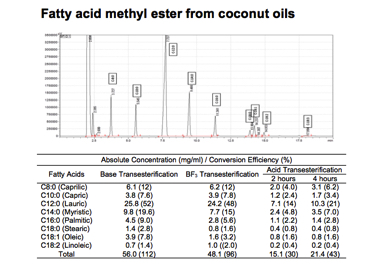Gas Chromatographic Analysis of Medium Chain Fatty Acids in Coconut Oil
Abstract

Analysis of medium chain of fatty acids in coconut oil becomes important due to their roles in health issues. The present analysis methods for fatty acids present in food mainly focused to the overall fatty acid concentration. The analytical method for specific medium chain fatty acids is not so much be given attention. This research is focused to the analytical methods for these particular fatty acids in coconut oil. Several analytical methods were compared including acid catalyzed, basic catalyzed and acid boron trifluoride catalyzed derivatization. The response of each fatty acid toward the derivatization methods are different. Formation of the fatty acid methyl ester from caprylic and capric was low for acid catalyzed method compared to basic catalyzed method and acid boron trifluoride catalyzed methods. This finding shows that the kinetics of the esterification among the fatty acids are not the same. The analysis of all fatty acids in coconut oil is better using basic catalyzed than the other methods.
References
[1] Turner, N., K. Hariharan, J. Tidang, G. Frangioudakis, S. Beale, L. Wright, X. Zeng, S. Leslie, J. Li, E. Kraegen, G. Cooney and J. Ye. Diabetes. 2009. 58:2547-2554.
[2] APCC. Proposed APCC Standard for Virgin Coconut Oil. APCC Session-XLI-2008/008. Agenda Notes of the XLI APCC Session. 19 - 22 October 2004. Tarawa, Kiribati. Asian and Pacific Coconut Community. http://www.apccsec.org/document/VCO-STANDARDS.pdf Accessed date: January 15, 2016.
[3] Marten, B., M. Pfeuffer, and J. Schrezenmeir. Medium chain triglycerides. Int. Dairy J. 2006. 16:1374-1382.
[4] Wilson, T., D. Kritchevsky, T. Kotyla, and R. Nicolosi. Biochim. Biophys. Acta 2006. 1761:345-349.
[5] Christie, W.W. Gas chromatography and Lipids: A Practical Guide. 1989. The Oily Press, Scotland.
[6] IUPAC. Standard method for analysis of oils, fats and derivatives. 1987. Blackwell Scientific Publications. IUPAC Method 2.301.
[7] Araujo, P., T. Nguyen, L. Freyland, J. Wang and J. Kang. Evaluation of a rapid method for the quantitative analysis of fatty acids in various matrices. J. Chromatogr A. 2008. 28:106-113.
[8] Anonymous. Analysis of fatty acids. 2016. Cyberlipid Center. http://www.cyberlipid.org/cyberlip/home0001.htm. Accessed date January 15, 2016
[9] AOCS. Preparation of methyl esters of fatty acids. AOCS Method Ce 2-66 1997.
[10] Laureles, L. R., F. M. Rodriguez., C. E. Reano., G. A. Santos., A. C. Laurena., E. M. T. Mendoza. J. Agric. and Food Chem. 2002. 50: 1581 – 1586.
[11] Azeez, S. British Food J. 2007. 109:272-279.
[12] Moigradean, D., M. Poiana, L. Alda and I. Gogoasa. J. Agroalimentary Processes and Technologies. 2013. 19:459-463
[13] AOAC. AOAC Official method 969.33. Fatty acids in oils and fats. Preparation of methyl esters boron trifluoride method. AOAC International 2000.
[14] Lall, R., A. Proctor, and V. Jain. J. Am. Oil Chem. Soc. 2009. 86:309-314.
[15] Milinsk, M., M. Matsushita, J. Visentainer, C. Oliveira, and N. Souza. J. Braz. Chem. Soc. 2008. 19. 8.
[16] Khan, A. A GC-FID method for the comparison of acid and base catalysed derivatization of fatty acids to FAMEs in three edible oils. Thermo Scientific. Application Note 20733. 2013.
Refbacks
- There are currently no refbacks.









